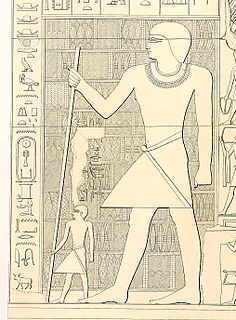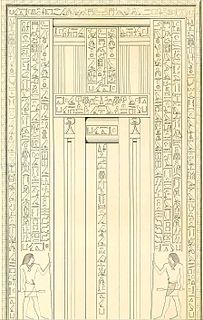
Djedkare Isesi was a pharaoh, the eighth and penultimate ruler of the Fifth Dynasty of Egypt in the late 25th century to mid-24th century BC, during the Old Kingdom. Djedkare succeeded Menkauhor Kaiu and was in turn succeeded by Unas. His relations to both of these pharaohs remain uncertain, although it is often conjectured that Unas was Djedkare's son, owing to the smooth transition between the two.
Ptahhotep, sometimes known as Ptahhotep I or Ptahhotpe, was an ancient Egyptian vizier during the late 25th century BC and early 24th century BC Fifth Dynasty of Egypt.

Khnumhotep and Niankhkhnum were ancient Egyptian royal servants. They shared the title of Overseer of the Manicurists in the Palace of King Nyuserre Ini, sixth pharaoh of the Fifth Dynasty, reigning during the second half of the 25th century BC. They were buried together at Saqqara and are listed as "royal confidants" in their joint tomb. They are notable for their unusual depiction in Egyptian records, often interpreted as the first recorded same-sex couple, a claim that has met considerable debate.

Isesi-ankh was an ancient Egyptian high official during the second half of the Fifth Dynasty, in the late 25th to mid 24th century BC. His name means "Isesi lives". He may have been a son of pharaoh Djedkare Isesi and queen Meresankh IV, although this is debated. Isesi-ankh probably lived during the reign of Djedkare Isesi and that of his successor Unas. He was buried in a mastaba tomb in north Saqqara, now ruined.

Rashepses was a vizier from the Fifth Dynasty of Egypt. Rashepses was vizier under Djedkare Isesi. A letter directed to Rashepses has been preserved. This decree is inscribed in his tomb in Saqqara. As vizier he was one of the most important Ancient Egyptian officials. In his tomb are many titles recorded. It seems that he was first overseer of the scribes of the royal documents, overseer of the two granaries and overseer of all royal works. These are all very important titles, making him an influential official at the royal court. At the final stage of his career he became vizier. The vizier title is only preserved in two letters that are copied on the decoration of the tomb. It seems that most of his tomb was finished and after all that, he was promoted.

Meritites II or Meritites A was a 4th Dynasty Princess of Ancient Egypt, and probably a daughter of King Khufu. She may have been a daughter of Meritites I based on the fact that this queen is mentioned in mastaba G 7650. She married the Director of the Palace Akhethotep and she had several children with her husband. Meritites and her husband shared a mastaba G 7650 in Giza.

Akhethetep was a high dignitary of ancient Egypt who lived during the Fifth Dynasty around 2400 BC. Akhethotep and his son Ptahhotep Tjefi were senior court officials during the rule of Djedkare and of Unas (Wenis), towards the end of the 5th Dynasty. Akhethetep's titles included that of a vizier, making him to the highest official at the royal court, only second to the king. He was also overseer of the treasuries, overseer of the scribes of the king's documents and overseer of the granaries. Akhethetep was the son of Ptahhotep. His father was vizier too.
Kaemtjenent was an ancient Egyptian official under pharaoh Djedkare Isesi in the late Fifth Dynasty, during the Old Kingdom period.

Seshemnefer was an ancient Egyptian official of the Fifth Dynasty, most likely under king Djedkare Isesi. At the end of his career he became vizier, the highest office in Ancient Egypt, second only to the king.
Ptahhotep Desher was an Ancient Egyptian official at the end of the Fifth Dynasty, most likely in office under kings Menkauhor Kaiu and Djedkare Isesi. His main function was that of a vizier. This was the most important office in Ancient Egypt, second only to the king. Ptahhotep also held other titles, such as overseer of the six great houses, overseer of the scribes of the royal documents and overseer of all royal works. These are all important functions, often held by a vizier.

Pehenuikai was an Ancient Egyptian official of the Fifth Dynasty. His main office was that of a vizier, making him to the most important man at the royal court, only second to the king. Beside being vizier, he was also holding many other important titles, such as Overseer of the treasuries, overseer of the scribes of the king's document, overseer of the double granary and overseer of all royal works of the king.
Kay was an Ancient Egyptian official living most likely in the Fifth Dynasty. He is mainly known from his mastaba in Saqqara North. Kay hold a high number of important titles making him the most powerful of his time, only second to the king. His main office was that of a vizier. Beside being vizier, he was also holding many other important titles, such as Overseer of the treasuries, Overseer of Upper Egypt, overseer of the scribes of the king's document, overseer of the six big houses and overseer of all royal works of the king. His mastaba in Saqqara was recorded by Gaston Maspero who assigned to it the number D 19. Kay was bearing 51 titles, making him the vizier with the highest numbers of titles. Kay was the first Egyptian official with the title overseer of the six big houses. The office became one of the most important at the royal court in the later Fifth Dynasty and continued to be so during the subsequent Sixth Dynasty.
Washptah, with the second name Izi, was an ancient Egyptian official in the Fifth Dynasty under king Neferirkare Kakai. His most important title was that of a vizier, making him to the most important official at the royal court, only second to the king. Next to the office of the vizier he hold several other important positions, including overseer of the scribes of the king's document and overseer of all royal works.
Seshathetep, also called Heti, was an ancient Egyptian official at the beginning of the Fifth Dynasty. Seshathetep held many important titles, possibly including that of vizier. With this latter title, he would have been the most important official at the royal court, second only to the king. He also bore the title of king's son of his body, yet it is doubtful that Seshathetep was the real son of a king.
Ptahhotep was an ancient Egyptian official of the Fifth Dynasty, most likely under king Djedkare Isesi. His most important office was that of a vizier, making him to the most important official at the royal court, only second to the king. Next to this important office he held further important titles, such as overseer of the treasuries, overseer of the scribes of the king's document, overseer of the six big houses and overseer of all royal works of the king.
Akhethetep Hemi was an ancient Egyptian official at the end of the Fifth Dynasty, most likely in office under king Unas. His highest title was that of a vizier, making him to the most important official at the royal court, only second to the king. Next to the vizier's titles he was also overseer of the treasuries, overseer of the scribes of the king's document and overseer of the double granary, all these are important position at the royal court.
Ihy was an Ancient Egyptian official of the Fifth Dynasty, in office most likely under king Unas. Ihy was vizier and was therefore the most important official at the royal court only second to the king. Next to the titles of a vizier, he was also overseer of the treasuries, overseer of the scribes of the king's document, overseer of all royal works and overseer of the double granary. These are also important titles, demonstrating his important position at the royal court.
Izi was an important ancient Egyptian official of the Fourth Dynasty. His most important title was overseer of the treasury. Other important titles he hold are scribe of the king's document, overseer of the great house and overseer of the king's ornament.
Qar was an official of the Sixth Dynasty of Egypt. Son of Idu, he probably lived and served between Merenre I and Pepy II.
Idu was an official during the Sixth Dynasty, buried in Giza East Field, tomb G7102. He probably lived and served during the reign of Pepi I Meryre. He is the father of Qar whose tomb is nearby and Bendjet, buried in G7215.







